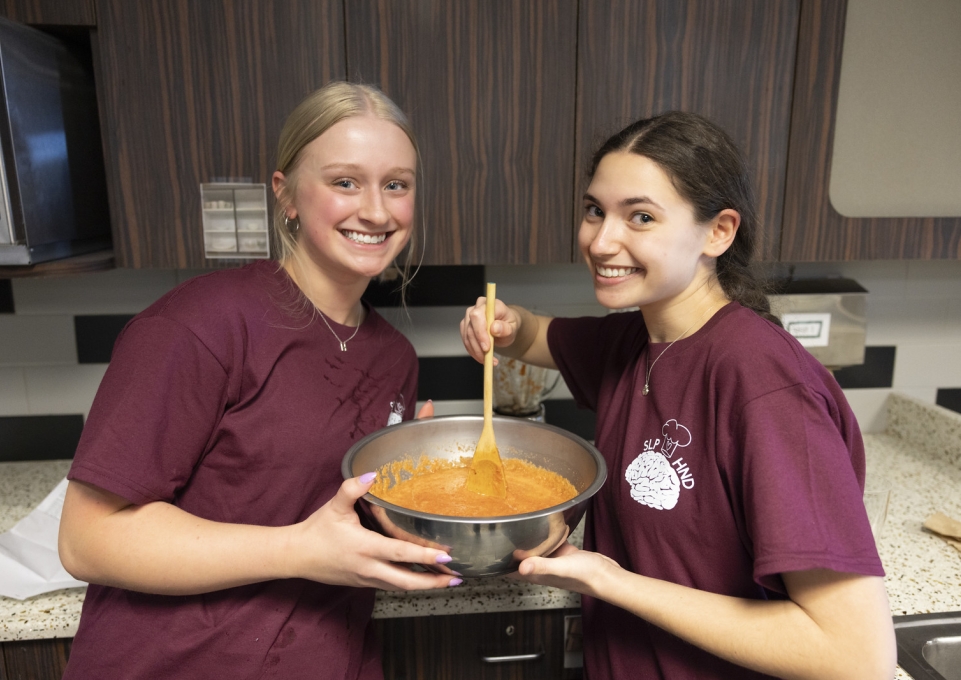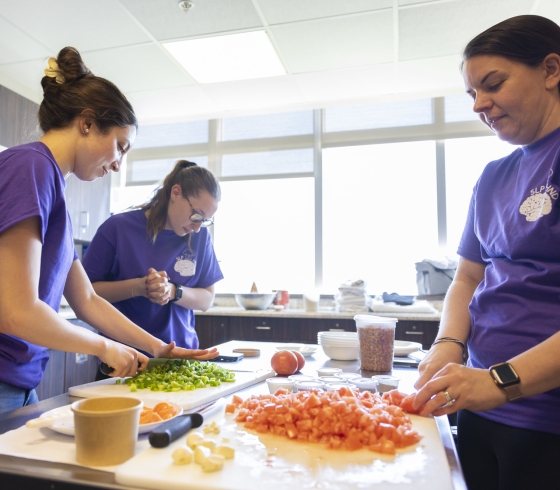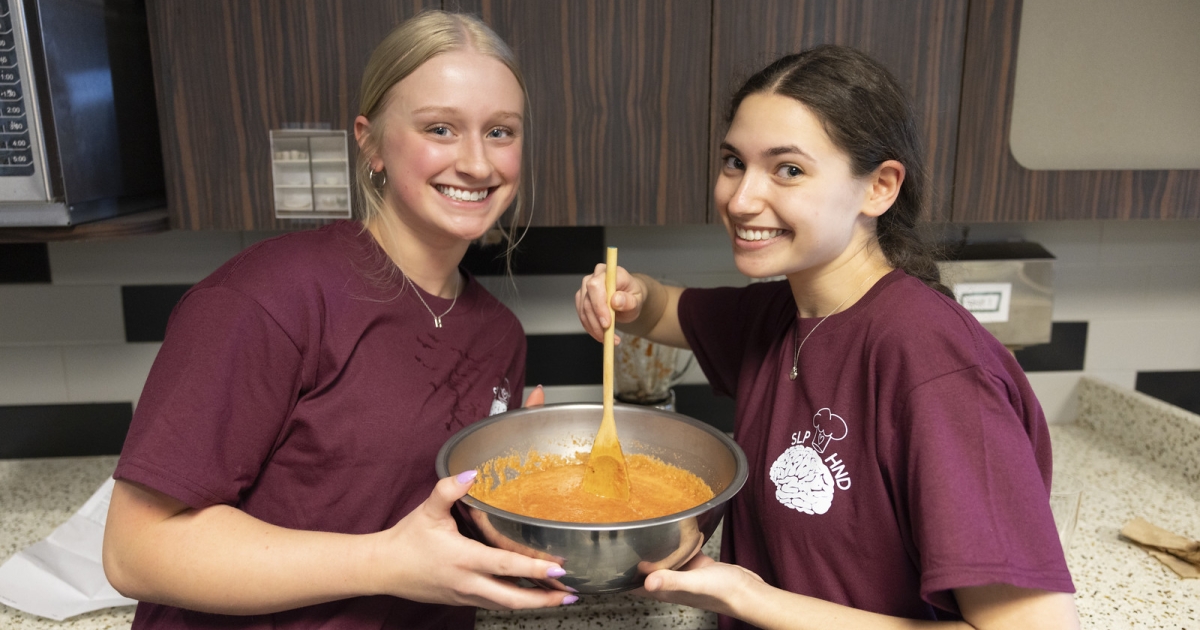
The heat was on in Caudell Hall as students from Buffalo State University’s Speech-Language Pathology (SLP) and Health, Nutrition, and Dietetics (HND) departments participated in the second annual Interdisciplinary Iron Chef Competition on April 25.
“Just by opening the door and getting a whiff of the aromas in this room, I know this is going to be a great competition,” said Buffalo State Interim President Bonita R. Durand, Ph.D., in an address to attendees before the event. “I don’t think there are going to be any losers.”
And while teams technically were awarded prizes at the end of the event, Durand was right: all participants took home the winning experience of working across disciplines to create dishes that suited the needs of a fictitious patient, an experience designed to simulate their work in the professional world.
The competition mimics the Food Network’s cooking show Iron Chef America, which is based on the Japanese cult sensation Iron Chef. Five teams of five—made up of students from SLP and HND—are tasked with creating dishes that meet the swallowing and dietary requirements of a clinical case while maintaining taste and visual appeal. (Students supply lists in advance; Chartwells Dining provides portioned ingredients.) The winning team presents its dish to the Chartwells team at Bengal Kitchen and the staff at Campus House. The competition was funded through the Grant Allocation Committee.
Dietary recommendations are often difficult for patients, resulting in poor adherence, explained event hosts Elizabeth Hartz, lecturer of HND and clinical coordinator of the campus’s Nutrition Education Counseling Center (NECC), and Anita Senthinathan, assistant professor of SLP.
“This event provides an opportunity for the campus community to learn more about the challenges associated with medical conditions and swallowing recommendations,” Senthinathan said. “I hope this encourages students to think about the importance of food enjoyment and a more holistic approach to health care."
The competition also helps students learn about another allied health-care field. “It’s important they learn the scope of each other’s discipline because of how closely we work together,” Hartz said.
Jeffrey Hirschfelt, lecturer of hospitality and tourism, director of Campus House, and the event’s master of ceremonies, told students, “When you go to a job, you have to work across disciplines and across different departments. If you are in a hospital setting, you may have to work with a nutritionist or a speech-language pathologist, so this [event] is really a great opportunity.”

Recipes were created based on the clinical case, which provided a full patient profile: age, cultural considerations, medical history, dietary restrictions and preferences, SLP recommendations, required nutritional status, and results of a videofluoroscopic swallowing study. This year’s patient was vegan and of Zulu descent with a history of type 2 diabetes and hypertension (high blood pressure) and had recently been using a feeding tube following a traumatic brain injury and cervical spine injury as the result of a car crash.
While the teams were hard at work, spectators at the standing-room-only event enjoyed refreshments and participated in a game of trivia. “It was exciting seeing this year’s event develop into a more interactive experience for the audience,” said Hartz. “It gave the audience a chance to not only learn but also win.” Prizes included lunch for two at Campus House, event T-shirts, and an opportunity to sample the final dishes.
The judges’ panel comprised Glenn Bucello, resident district manager of Chartwells; Carol DeNysschen, dean of the School of the Professions; Katherine Manis, lecturer and director of the nutrition and dietetics program; Kathleen McNerney, associate professor and chair of the SLP Department; and Christina Mulé, a clinical supervisor in the SLP program, who is partially credited with the idea for the event.
As Hirschfelt invited teams to the front of the room to present, he emphasized the importance of explaining the dishes in layman’s terms because—while only the judges were able to taste—the audience votes for “fan favorite” would be based on visual appeal and description alone. Cameras allowed attendees to see the dishes on monitors throughout the room.
In the end, Chelsea Cohn, Taylor DeSimone, Hannah Galloway, Dylan Loucks, and Nicholas Marrara—Team Maroon—were crowned the winners by both judges and audience alike for their spin on a traditional African rice dish they dubbed “Volcano of Love.” The team was commended for its consideration of the patient’s medical and cultural background, and creative recipe modifications to incorporate important nutrients, such as adding black beans for increased fiber and protein and pureeing vegetables in the dish’s hot sauce. Mindful of the patient’s hypertension, the students avoided salt—instead focusing on cumin, garlic powder, and paprika—and amped up the potassium.
“We added sautéed kale to the rice for increased potassium,” Marrara, a junior dietetics major, explained during the presentation. “Potassium has been shown to decrease blood pressure in hypertensive patients.”
“We decided to go with a minced moist dish,” added DeSimone, a second-year graduate student in the SLP Department. “It’s really easy to chew for a patient coming off of a feeding tube.”
As cleanup began, Loucks, Galloway, and Cohn—all first-year graduate students in the SLP program—reflected on the experience.
“I was nervous coming in because I don’t cook that much,” Loucks said. “I had to rely on my team a lot for guidance, but they were very good at guiding me in the right direction.”
“We had so much fun,” Galloway added. “We had good communication and helped each other.”
“Interdisciplinary work is always talked about in class,” Cohn said, “but it’s great to see it applied through something we’ll be doing as we go off into clinical fellowships and out into the field. It was great to experience that in a safe and supportive environment.”
Durand commended the students’ teamwork and the cross-disciplinary and cross-departmental efforts at the heart of the event. “That’s what Buffalo State is all about,” she said, “learning to work with different individuals, experiencing different cultures and ways of doing things, learning to grow, and enhancing social and political skills in addition to academics.”
Photos by Jesse Steffan-Colucci, Buffalo State photographer.
Video by Ken Giangreco, John Myers, and Dave Ross, Buffalo State Marketing and Communications Office.



